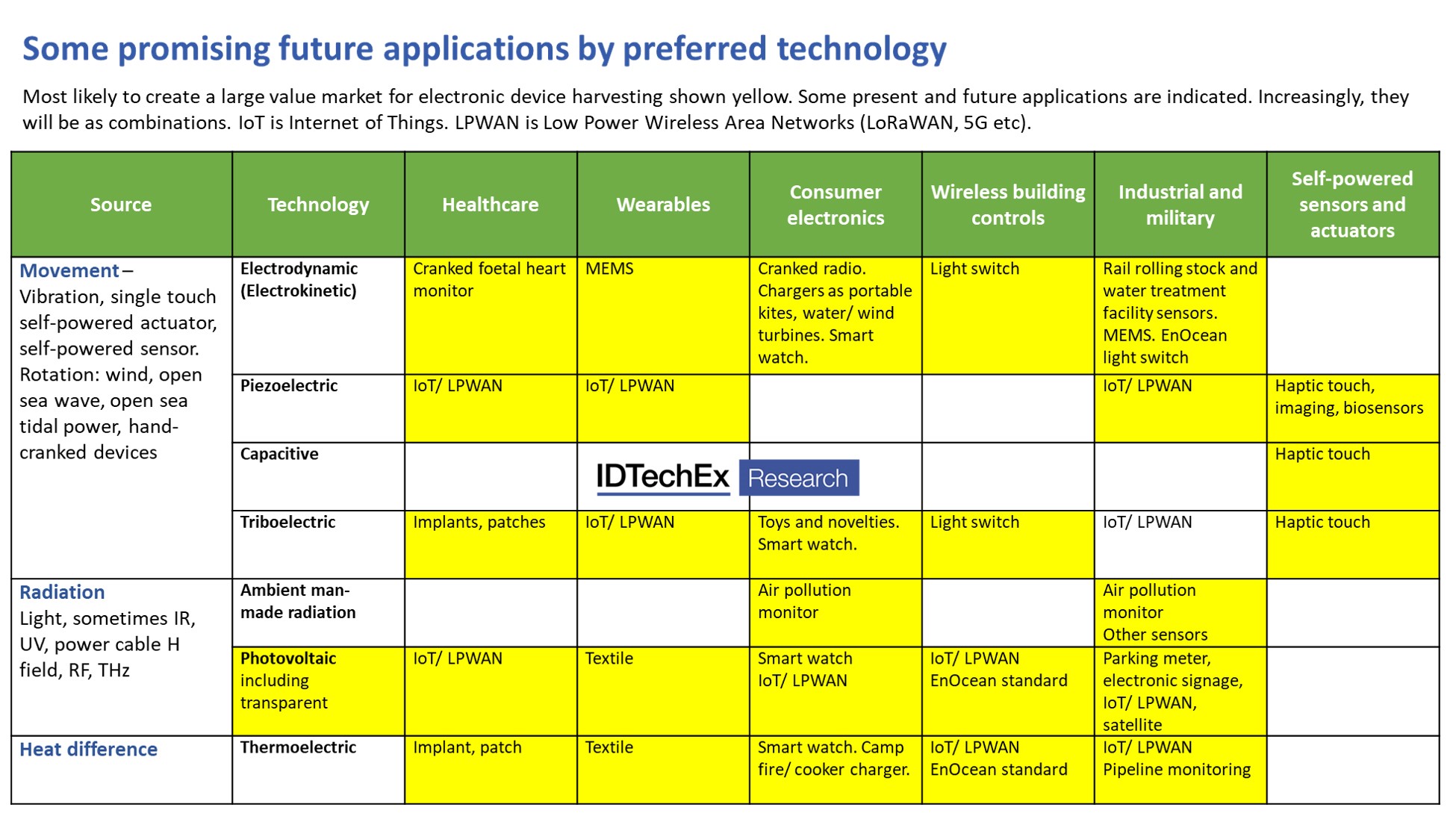Self-charging everything: battle for the high ground
When some full-function, always-on smartwatches are able to self-charge, the others will look like the horse-drawn cart. When Internet of Things nodes are self-charging at the right size and price, the market for them will increase one thousand times.
The new 220 page IDTechEx report, 'Energy Harvesting for Electronic Devices 2020-2040' comes at just the right time. The world’s first self-powered smartwatches have just arrived.
They are not full function but we are getting there by making electricity from heat, movement and light, increasingly in combinations. That billion-a-year smartwatch potential will be followed by similar numbers of IoT nodes. Conquering that high ground will enable solutions for Tesla vehicle electronics, Airbus aircraft and much more.

Some promising future applications by preferred technology. Most likely to create a large value market for electronic device harvesting shown yellow. Some present and future applications are indicated. Increasingly, they will be as combinations. IoT is Internet of Things. LPWAN is Low Power Wireless Area Networks (LoRaWAN, 5G etc.) Source: IDTechEx report 'Energy Harvesting for Electronic Devices 2020-2040'.
The pendulum generator basic smartwatch competes with one that melds thermoelectrics and solar. A new Garmin smartwatch gets some help from solar glass. All three next? There are precedents. EnOcean wireless, no-battery building controls already harvest up to three modes.
The new 20-year forecasts incorporate that multiplier effect powering sales of harvesters for use in electronic devices to well beyond $2bn in 2030 and much more beyond. What next? Winners? Losers? Technology roadmaps and sales forecasts? All in the report because of its unique scope and PhD level insights from multi-lingual IDTechEx analysts.
Energy independent low power wireless networks, 5G devices, smart skin patches electrically powered by sweat, implants and medical wearables powered by heartbeats, temperature differences, blood flow. All are being demonstrated.
The 25-page executive summary and conclusions are easily read because many new infograms pull together the needs, challenges and potential, comparing forecasts, leaders, market drivers and battery elimination milestones ahead. Dip into the next 25 pages of new 20 year forecasts as you wish - triboelectric, photovoltaic, electrodynamic, thermoelectric, piezoelectric and others backed by forecasts for those smartwatches, pico products, wearable technologies, medical, IoT and other uses.
Chapter 2 introduces the principles, compares the technologies in many ways including vibration harvesting parameters achieved, what exactly is needed and companies to contact. Chapter 3 explains 12 photovoltaic technologies and their future.
Chapter 4 explains why IDTechEx believes that triboelectrics is coming from nowhere with its initial sales of battery-free, dust-filtering, electric face masks in 2019 to be a strong contender overall. It will use non-toxic, affordable materials in a dazzling array of applications. An example is work on a smartwatch integral battery + harvester in one smart composite with two harvesting modes. The Chinese government is now massively supporting triboelectric harvester research with many research centres and over 200 PhD projects at a time.
Chapter 5 explores the burgeoning thermoelectric improvements and applications from smartwatches to IoT nodes and fit-and-forget industrial uses. Chapter 6 surprises with electrodynamics technology presented and how it has already replaced tens of millions of batteries by using instead, microturbine and micro-pendulum generators in electronic toilets, pipeline sensors, watches and pitched for IoT. Hand-crank and pull-charged medical and consumer electronics are proliferating.
Why the big effort on electrodynamic, thermoelectric and other harvesting in humans? Here is just part of the answer. We need fit-and-forget electronic implants dealing with the epidemic of diabetes. Heart pacemakers saved over three million lives, but the 600,000 pacemakers now implanted every year have batteries lasting no more than seven years. Fit-and-forget please. They are sometimes fitted to two-year-olds.
Chapter 7 does it all for piezoelectrics. Chapter 8 rounds off with harvesting man-made ambient electromagnetic radiation from 50Hz power lines to the new ambient terahertz inventions and also other harvesting. Throughout the report, common themes include flexible, transparent, biocompatible and stretchable versions to transform wearables and healthcare.
Battery elimination can include demonstrated stretchable, woven supercapacitors. The IDTechEx report, 'Energy Harvesting for Electronic Devices 2020-2040' identifies many gaps in the market. No nostalgia or obscure calculations. The emphasis is on creating new business and benefitting society.










